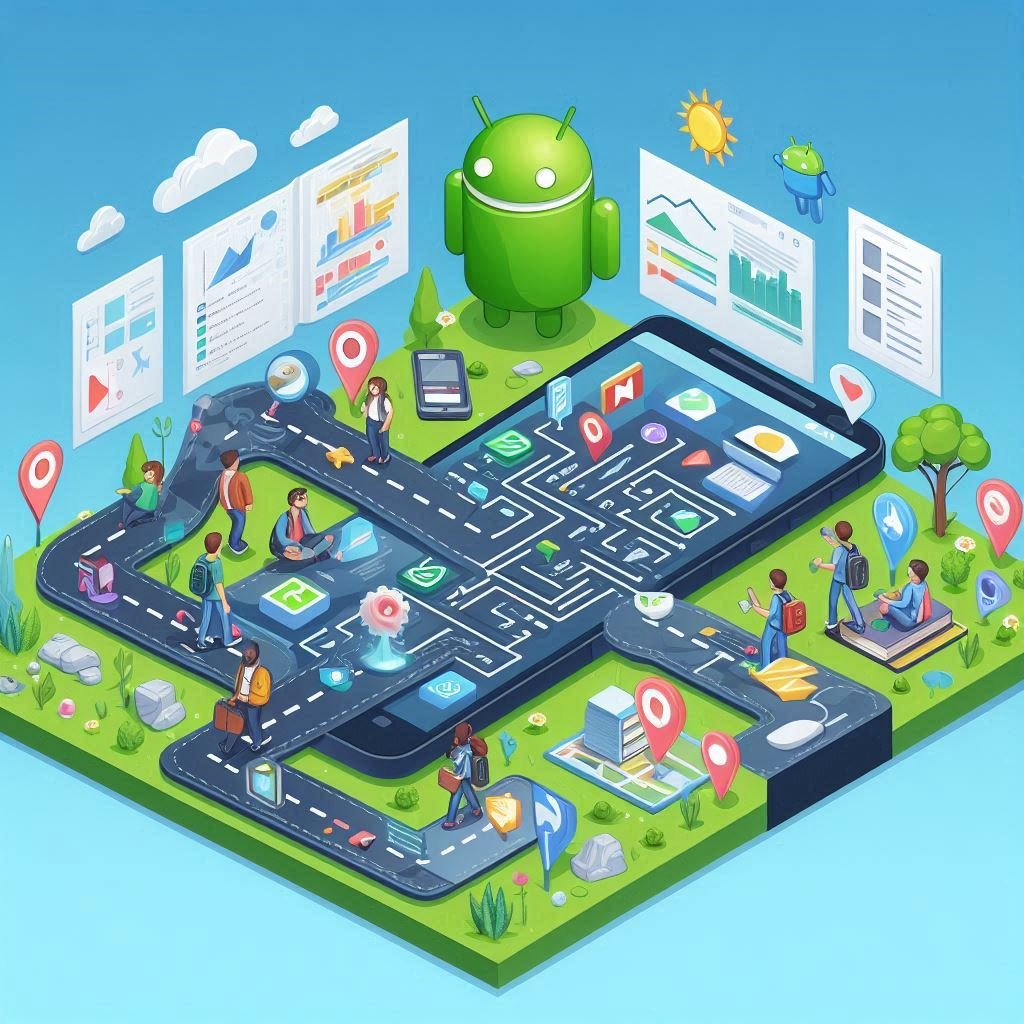
Roadmap to Learning Android App Development in Java
Learning Android app development with Java is a structured journey, giving you the skills to create powerful, scalable, and widely-used mobile applications. Java was the original language for Android development and is still highly relevant today. Here’s a roadmap to guide you in mastering Android app development with Java.
1. Master the Basics of Java
Start by building a strong foundation in Java, as it is essential for Android app development.
- Key Java Concepts to Learn:
- Basic Syntax: Understanding Java syntax and basics like data types, variables, and operators.
- Control Flow: Learn
ifstatements, loops (for,while,do-while), and switch cases. - Object-Oriented Programming (OOP): Study the pillars of OOP—encapsulation, inheritance, polymorphism, and abstraction.
- Exception Handling: Understand try-catch blocks and custom exception handling.
- Collections Framework: Work with collections like Lists, Sets, Maps, and how to iterate through them.
- Multithreading: Understand the basics of threads and the
Runnableinterface. - Recommended Resources:
- Java Documentation
- Java tutorials on YouTube, Udemy, and Coursera
- Books like Effective Java by Joshua Bloch and Head First Java by Kathy Sierra & Bert Bates
2. Set Up Your Android Development Environment
Now that you’re comfortable with Java, start setting up your Android development environment.
- Install Android Studio: Android Studio is the official Integrated Development Environment (IDE) for Android development.
- Understand Project Structure: Familiarize yourself with Android project structure, including
res,java,manifest, and Gradle files. - Core Components of Android:
- Activities and Fragments: Understand activities as the entry point of your app’s user interface and fragments for modular and reusable UI sections.
- Intents and Broadcast Receivers: Learn about component communication within an app.
- Services and Background Work: Study how to run long-running background tasks.
- Content Providers: Learn about data sharing between applications.
- Recommended Resources:
- Android Developer Documentation
- Beginner courses on Android basics in Java (such as those on Udemy or Coursera)
3. Learn User Interface (UI) Design
User Interface design is crucial for Android apps. Start by understanding layouts and UI components using XML, then explore Android’s design principles.
- XML Layouts: Learn to create UIs with XML, understanding
TextView,Button,ImageView,EditText, and layout structures likeLinearLayout,RelativeLayout, andConstraintLayout. - RecyclerView and ListView: Learn to display lists of data using RecyclerView and ListView, and understand their differences.
- Material Design: Android’s Material Design guidelines help create visually appealing and user-friendly interfaces.
- View Binding: Simplifies accessing views in XML layout files.
- Recommended Resources:
- UI design courses and tutorials from Android Developers
- Material Design guidelines from Google
4. Understand Navigation and User Interaction
User interaction and seamless navigation are essential for Android app usability. Familiarize yourself with these elements.
- Navigation Component: Use the Jetpack Navigation Component to simplify navigation.
- Dialogs, Toasts, and Snackbars: Learn to provide feedback to users.
- User Input Handling: Understand how to handle user inputs from
EditText, form validation, and working with keyboards. - Touch Events and Gestures: Gain an understanding of basic touch and gesture handling.
- Recommended Resources:
- Codelabs on Navigation Component and RecyclerView
- Interactive UI element tutorials on YouTube
5. Explore Data Storage and Persistence
Android apps need to manage data efficiently, and Android offers several options for data storage.
- SharedPreferences: Store simple data as key-value pairs, such as user settings.
- Room Database: Room is a Jetpack library for using SQLite databases with an ORM for Android.
- Content Providers: Share data between applications.
- Networking: Use libraries like Retrofit for API requests and Gson for JSON parsing.
- Recommended Resources:
- Android Room documentation
- Retrofit documentation and sample projects on GitHub
6. Learn About Multithreading and Asynchronous Programming
Multithreading and asynchronous programming are essential for ensuring smooth performance in Android apps.
- AsyncTask (Deprecated): Understand AsyncTask for performing background operations (though it’s now deprecated).
- Handler and HandlerThread: Use these for posting runnable tasks on specific threads.
- Java Threads and Executors: Understand using threads and the
ExecutorService. - RxJava and Kotlin Coroutines: Familiarize yourself with RxJava for reactive programming (useful for experienced developers).
- Recommended Resources:
- Android documentation on background processes
- RxJava tutorials and basic multithreading guides
7. Use Dependency Injection
Dependency Injection (DI) helps in writing modular and testable code. This is especially beneficial as your applications grow.
- Dagger: Learn Dagger, a popular DI framework used for Android.
- Hilt: Built on Dagger, Hilt simplifies DI in Android by providing integrations with standard Android components.
- Koin: An alternative DI library that is simple and Kotlin-based, but it also works well with Java projects.
- Recommended Resources:
- Dagger documentation
- Dependency Injection in Android guides and tutorials on YouTube
8. Master Jetpack Components
Android Jetpack is a suite of libraries that simplifies Android development, making it more efficient and manageable.
- ViewModel: Manage UI-related data in a lifecycle-conscious way.
- LiveData: An observable data holder class for UI updates.
- WorkManager: Schedule background work that needs to be guaranteed to execute.
- Paging: Efficiently manage large data sets in RecyclerView.
- Navigation: Simplifies in-app navigation, making transitions and back-stack management easier.
- Recommended Resources:
- Jetpack documentation and codelabs
- Tutorials on Jetpack components on Google’s Android YouTube channel
9. Learn Testing in Android Development
Testing is a crucial aspect of ensuring app quality. Android supports several types of testing.
- Unit Testing: Learn JUnit for testing individual components of your code.
- UI Testing: Use Espresso to test UI elements and user interactions.
- Mocking Dependencies: Use tools like Mockito to create mocks for dependencies, making testing simpler and more isolated.
- Recommended Resources:
- Android Testing documentation
- Google’s Android Testing codelab and tutorials
10. Build, Publish, and Maintain Your App
The final stage is to publish and maintain your app, bringing your work to users.
- Generate APK and App Bundle: Learn to create a signed APK or app bundle for the Google Play Store.
- Google Play Console: Understand how to manage your app on the Play Store, track analytics, and respond to user feedback.
- App Maintenance: Learn about using tools for crash reporting, app analytics, and user feedback.
- Recommended Resources:
- Google Play Console documentation
- Tutorials on releasing Android apps on YouTube
Suggested Roadmap Timeline
Here’s a suggested timeline for learning Android development with Java:
| Stage | Estimated Time |
|---|---|
| Java Basics | 2–4 weeks |
| Android Basics | 2–3 weeks |
| UI Design | 3–4 weeks |
| Navigation and User Interaction | 2–3 weeks |
| Data Storage | 3–4 weeks |
| Multithreading and Async Programming | 2–3 weeks |
| Dependency Injection | 1–2 weeks |
| Jetpack Components | 3–5 weeks |
| Testing | 2–3 weeks |
| App Publishing and Maintenance | 1–2 weeks |
Conclusion
This roadmap provides a comprehensive guide to mastering Android app development with Java. Remember, hands-on practice is essential—try building small projects after each module, explore open-source projects, and stay updated with the latest Android technologies. With dedication and practice, you’ll be well on your way to becoming a skilled Android developer.


